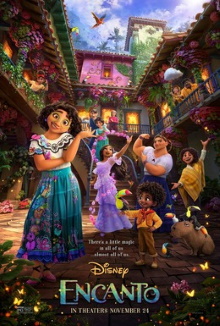I have almost no interest in any of the Disney animated films these days as my watch list is too crammed to bother with work that might only be marginally interesting. This one made the cut largely because it’s set in Colombia and features heavy use of Spanish, plus its songs were written by Lin-Manuel Miranda. I’d say it counts as a great success as pure spectacle and I do like how Disney seems to be moving towards stories where the conflict is purely internal such that there are no external enemies to defeat. The songs are great too though I can detect they are trying hard to rekindle the magic of Frozen. The plot is rather thin though and it relies on the song and dance sequences to distract audiences from that fact.
Mirabel Madrigal is proud and happy to be part of the Madrigal clan who live in a secluded village in Colombia. However she is the only member of the family who has not been gifted magical powers by the miraculous candle that created their sentient house and keeps their village safe from invaders. The matriarch of the family is Mirabel’s grandmother Alma who lost her husband decades ago fleeing from danger and was only saved by the miraculous appearance of the candle. One evening the family gathers to perform the traditional ceremony in which new members, in this case the 5-year-old Antonio, receive their powers. After Mirabel’s experience they are worried about the candle’s power weakening. They are relieved when Antonio is granted the power to communicate with animals. Yet Mirabel witnesses cracks forming in the structure of the house and the flame of the candle flickering and vows to learn what is happening.
This film exemplifies Disney’s current approach to not only draw from more diverse cultural sources but to do so more deeply and authentically. This effort can be seen not just in the heavy use of the Spanish language but also in casting South American voice actors as much as possible. I’m poorly qualified to judge how authentic the result is but I can appreciate how this determined effort makes the film richer both visually and audibly. The color palette used here is so vivid it looks almost surreal and I loved how the Spanish songs and words helps refresh the standard Disney formula. The songs are mostly good enough that they were hits in their own right and Disney continues to work hard to ensure that their CGI remains state of the art. This is the modern Disney at its best and it makes for a wonderful spectacle.
In lieu of a plot, we get what are in effect a series of character portraits as Mirabel discovers facets of her family members that she never knew. This is mostly accomplished by the characters each having their own song, which is how it manages to fit in all of the members of a large family within a film of average length. The prevailing theme is that everyone has their own inner doubts and worries no matter how strong or how good their life seems from the outside. Pretty par for the course for Disney but not unwelcome. More subversive is the intergenerational conflict as the family’s problems are really about the younger generation feeling pressured by the expectations of their elders and not being able to be themselves. We can see this in Mirabel herself who keeps claiming to be fine that she doesn’t have magical powers like the rest of her family but of course still feels that she has let them down. I like this theme more but of course this is an American take on individual choices and happiness even within the context of a large family and a wider community.
These Disney big budget productions are of course consumer products made to cater to very large and diverse markets and so it’s unreasonable to expect much in the way of original art from them. Within these constraints, I think this is a pretty decent film. I like the Columbian setting and the heavy use of Spanish but I dislike how the locale is confined to the Casita, magical though it is. It’s okay but it’s nothing more than that.
